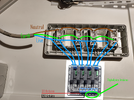Hi everyone. For my "meat aging machine" project I need to turn on and off multiple devices remotely according to the value of temperature ad humidity read by a sensor. I want to make a power strip with 4 outlets. I want to control each of those with a solid state relay (I have a module of 4). Is it safe to wire it like I show in the figure below? The solid state relay module will be in a separate box and Arduino will be in a third box. My concern is about those 5V, GND and signal cables that go from the 220AC box, where the relay module is, to the 5V Arduino box. Is there any way to wire this more safely? Sorry for my ignorance, I'm here to ask you since I don't want to hurt myself. Thank you very much in advance.


